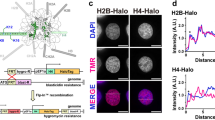Abstract
Purified DNA has been prepared from Drosophila virilis using a modification of the method derived for bacteria (Marmur, 1961). Some physical properties have been examined, a new hidden satellite discovered, and a difference found in the satellite banding pattern of different tissues. — In addition to the three satellite bands lighter than the main band previously reported (Gall et al., 1970), a new satellite heavier than the main band has been detected after thermal denaturation of the DNA (which substantially shifts the buoyant density of the main band but not that of the satellites indicating that all are fast-annealing). The satellite pattern of DNA extracted from heads alone differed from that of the entire animals: the amount of satellite I was decreased and II increased; III was unaffected; IV was increased relative to the amount in the main band. The total content of satellite material in the heads (assumed to be entirely diploid) was 42%, the highest amount reported for any organism. — Thermal transitions were determined for the DNA from adults and larvae. After preparative CsCl density gradient fractionation of adult DNA, two sets of bimodal thermal curves were obtained (in SSC) with agreement between the initial position in the preparative gradient, the thermal transitions, and the G+C content from density except for satellite III for which the Tm gave a more accurate G+C amount. DNA from satellites I and II together generated a Tm of 81.2° which was similar to a calculated Tm of 81.9° making the naive assumption that the thermal components of the two satellites would interact in a simple additive fashion. A Tm of 71.9° was ascribed to satellite III which indicates that it is not the equivalent of the poly (A-T) band found at the same density in D. melanogaster (Fansler et al., 1970). The calculated overall base composition from the density equivalents (using the value for satellite III from thermal data) gave an expected G+C content of 36.6%. The measured value was 36.0%. The possible significance of the differential satellite pattern has been discussed.
Similar content being viewed by others
References
Ashburner, M.: Function and structure of polytene chromosomes during insect development. Advanc. Insect Physiol. 7, 1–96 (1970)
Baker, W.: Position-effect variegation. Advanc. Genet. 14, 133–170 (1968)
Baker, W.: Evidence for position-effect suppression of the ribosomal RNA cistrons in Drosophila melanogaster. Proc. nat. Acad. Sci. (Wash.) 68, 2472–2476 (1971)
Berendes, H. D., Keyl, H. G.: Distribution of DNA in heterochromatin and euchromatin of polytene nuclei of Drosophila hydei. Genetics 57, 1–13 (1963)
Blumenfeld, M., Forrest, H. S.: Is Drosophila dAT on the Y chromosome? Proc. nat. Acad. Sci. (Wash.) 68, 3145–3149 (1971)
Blumenfeld, M., Forrest, H. S.: Differential under-replication of satellite DNA's during Drosophila development. Nature (Lond.) New Biol. 239, 170–172 (1972)
Britten, R. J., Kohne, D. E.: Repeated sequences in DNA. Science 161, 529–540 (1968)
Corneo, G., Ginelli, E., Soave, C., Bernardi, G.: Isolation and characterization of mouse and guinea pig satellite deoxyribonucleic acids. Biochemistry 7, 4373–4378 (1968)
Doty, P., Marmur, J., Eigner, J., Schildraut, O.: Strand separation and specific recombination in deoxyribonucleic acids: Physical chemical studies. Proc. nat. Acad. Sci. (Wash.) 46, 461–476 (1961)
Eigner, J., Doty, P.: The native, denatured and renatured states of deoxyribonucleic acid. J. molec. Biol. 12, 549–580 (1965)
Fansier, G. S., Travaglini, E. C., Loeb, L. A., Schultz, J.: Structure of the Drosophila melanogaster dAT replicated in an in vitro system. Biochem. biophys. Res. Commun. 40, 1266–1272 (1970)
Gall, J. G., Atherton, D.: Satellite DNA sequences in Drosophila virilis. J. molec. Biol. (in press, 1973)
Gall, J. G., Cohen, E. H., Polan, M. L.: Repetitive DNA sequences in Drosophila. Chromosoma (Berl.) 33, 319–344 (1971)
Heitz, E.: Die somatische Heteropyknose bei Drosophila melanogaster und ihre genetische Bedeutung. Z. Zellforsch. 20, 237–287 (1934a)
Heitz, E.: Über α- und β-Heterochromatin sowie Konstanz und Bau der Chromomeren bei Drosophila. Biol. Zbl. 54, 588–609 (1934b)
Hennig, W.: Highly repetitive sequences in the genome of Drosophila hydei. I. Preferential location in the X chromosomal heterochromatin. J. molec. Biol. 71, 407–417 (1972)
Klett, R. P., Chabot, I. M., Smith, M., Hart, J. F. L.: Deoxyribonucleates of crabs of the superfamily Brachyrhyncha. Canad. J. Biochem. 47, 829–832 (1969)
Laird, C. D., McCarthy, B. J.: Magnitude of interspecific nucleotide sequence variability in Drosophila. Genetics 60, 303–322 (1968)
Mandel, M., Marmur, J.: Use of ultra-violet absorbance-temperature profile for determining the guanine plus cytosine content of DNA. In: Methods of enzymology XII B (L. Grossman and K. Moldave, eds.). New York: Academic Press Inc. 1968
Mandel, M., Schildkraut, C., Marmur, J.: Use of CsCl density gradient analysis for determining the guanine plus cytosine content of DNA. In: Methods in enzymology XII B (L. Grossman and K. Moldave, eds.). New York: Academic Press Inc. 1968
Marmur, J.: A procedure for the isolation of deoxyribonucleic acid from microorganisms. J. molec. Biol. 3, 208–218 (1961)
Mulder, M., Van Duijn, P., Gloor, H. J.: The replicative organization of DNA in polytene chromosomes of Drosophila hydei. Genetica ('s-Gravenhage) 39, 385–428 (1968)
Rae, P. M.: In: Advanc. Cell and molec. Biol. (DuPraw, ed.), vol. 2, p. 109. NewYork: Academic Press Inc. 1972
Rudkin, G.: Non replicating DNA in Drosophila. Genetics (Suppl.) 61, 227–238 (1969)
Schurin, M., Marmur, J.: Differences in the DNA of adult and larval forms of Drosophila virilis. Abstr. 1st ann. Meeting, Amer. Soc. Cell Biol., p. 193 (1961)
Skinner, D. M., Beattie, W. G., Kerr, M. S., Graham, D. E.: Satellite DNA's in Crustacea: Two different components with the same density in neutral CsCl gradients. Nature (Lond.) 227, 837–839 (1970)
Skinner, D. M., Triplett, L. L.: The selective loss of DNA satellites on deproteinization with phenol. Biochem. biophys. Res. Commun. 28, 892–897 (1967)
Yunis, J. J., Yasmineh, W. G.: Heterochromatin, satellite DNA, and cell function. Science 174, 1200–1209 (1971)
Author information
Authors and Affiliations
Rights and permissions
About this article
Cite this article
Schweber, M.S. The satellite bands of the DNA of Drosophila virilis . Chromosoma 44, 371–382 (1974). https://doi.org/10.1007/BF00284897
Received:
Issue Date:
DOI: https://doi.org/10.1007/BF00284897




